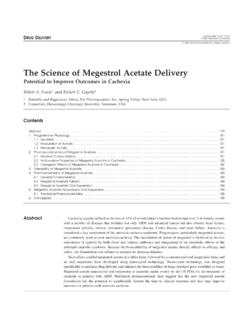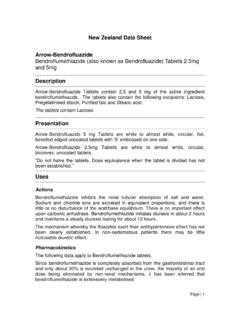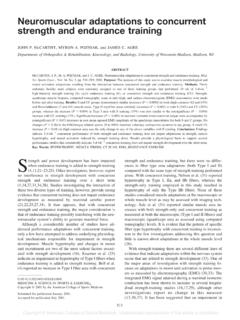Transcription of Renal Failure - Zhejiang University
1 433 CHAPTER24 Renal FailureAcute Renal FailureTypes of Acute Renal FailurePrerenal FailurePostrenal FailureIntrinsic Renal FailureClinical CourseDiagnosis and TreatmentChronic Renal FailureStages of ProgressionDiminished Renal ReserveRenal InsufficiencyRenal FailureEnd-Stage Renal DiseaseClinical ManifestationsAccumulation of Nitrogenous WastesDisorders of Water, Electrolyte, and Acid-Base BalanceMineral Metabolism and Skeletal DisordersHematologic DisordersCardiovascular DisordersGastrointestinal DisordersDisorders of Neural FunctionAltered Immune FunctionDisorders of Skin IntegritySexual DysfunctionElimination of DrugsTreatmentMedical ManagementDialysis and TransplantationRenal Failure in Children and Elderly PersonsChronic Renal Failure in ChildrenChronic Renal Failure in Elderly PersonsRenal Failure is a condition in which the kidneys fail to re-move metabolic end-products from the blood and regu-late the fluid, electrolyte, and pH balance of the extra-cellular fluids.
2 The underlying cause may be Renal disease,systemic disease, or urologic defects of nonrenal origin. Renalfailure can occur as an acute or a chronic disorder. Acute renalfailure is abrupt in onset and often is reversible if recognizedearly and treated appropriately. In contrast, chronic Renal fail-ure is the end result of irreparable damage to the kidneys. It de-velops slowly, usually over the course of a number of Renal FAILUREA cute Renal Failure represents a rapid decline in Renal functionsufficient to increase blood levels of nitrogenous wastes andimpair fluid and electrolyte balance. It is a common threat toseriously ill persons in intensive care units, with a mortalityrate ranging from 42% to 88%.1 Although treatment methodssuch as dialysis and Renal replacement methods are effectivein correcting life-threatening fluid and electrolyte disorders,the mortality rate associated with acute Renal Failure has notchanged substantially since the ,3 This probably is be-cause acute Renal Failure is seen more often in older personsthan before, and because it frequently is superimposed on otherlife-threatening conditions, such as trauma, shock, and most common indicator of acute Renal Failure is azote-mia, an accumulation of nitrogenous wastes (urea nitrogen,uric acid, and creatinine) in the blood.
3 In acute Renal Failure theglomerular filtration rate (GFR) is decreased. As a result, ex-cretion of nitrogenous wastes is reduced and fluid and elec-trolyte balance cannot be maintained. Persons with acute renalfailure often are asymptomatic, and the condition is diagnosedby observation of elevations in blood urea nitrogen (BUN) of Acute Renal FailureAcute Renal Failure can be caused by several types of conditions,including a decrease in blood flow without ischemic injury;ischemic, toxic, or obstructive tubular injury; and obstructionof urinary tract outflow. The causes of acute Renal Failure com-monly are categorized as prerenal (55% to 60%), postrenal(<5%), and intrinsic (35% to 40%).3 Causes of Renal failurewithin these categories are summarized in Chart FailurePrerenal Failure , the most common form of acute Renal Failure ,is characterized by a marked decrease in Renal blood flow. It isreversible if the cause of the decreased Renal blood flow can beidentified and corrected before kidney damage occurs.
4 Causesof prerenal Failure include profound depletion of vascular vol-ume ( , hemorrhage, loss of extracellular fluid volume), im-paired perfusion caused by heart Failure and cardiogenic shock,and decreased vascular filling because of increased vascular ca-pacity ( , anaphylaxis or sepsis). Elderly persons are particu-larly at risk because of their predisposition to hypovolemia andtheir high prevalence of Renal vascular vasoactive mediators, drugs, and diagnostic agentsstimulate intense intrarenal vasoconstriction and induce glomer-ular hypoperfusion and prerenal include hy-percalcemia, endotoxins, and radiocontrast agents such asthose used for cardiac of these agentsalso cause acute tubular necrosis (discussed later). In addition,several commonly used classes of drugs impair Renal adaptivemechanisms and can convert compensated Renal hypoperfusioninto prerenal Failure . Angiotensin-converting enzyme (ACE) in-hibitors reduce the effects of renin on Renal blood flow; whencombined with diuretics, they may cause prerenal Failure in per-sons with decreased blood flow caused by large-vessel or small-vessel Renal vascular disease.
5 Prostaglandins have a vasodilatoryeffect on Renal blood vessels. Nonsteroidal anti-inflammatorydrugs (NSAIDs) reduce Renal blood flow through inhibition ofprostaglandin synthesis. In some persons with diminishedrenal perfusion, NSAIDs can precipitate prerenal , the kidneys receive 20% to 25% of the large blood supply is required to remove metabo-lic wastes and regulate body fluids and electrolytes. Fortunately,the normal kidney can tolerate relatively large reductions inblood flow before Renal damage occurs. As Renal blood flow isreduced, the GFR drops, the amount of sodium and other sub-stances that is filtered by the glomeruli is reduced, and the needfor energy-dependent mechanisms to reabsorb these substancesis reduced. As the GFR and urine output approach zero, oxygenconsumption by the kidney approximates that required to keeprenal tubular cells blood flow falls below thislevel, which is about 20% of normal, ischemic changes of their high metabolic rate, the tubular epithelial cellsare most vulnerable to ischemic injury.
6 Improperly treated,prolonged Renal hypoperfusion can lead to ischemic tubularnecrosis with significant morbidity and Renal Failure is manifested by a sharp decrease in urineoutput and a disproportionate elevation of BUN in relation toserum creatinine levels. The kidney normally responds to a de-crease in the GFR with a decrease in urine output. An early signof prerenal Failure is a sharp decrease in urine output. BUN lev-els also depend on the GFR. A low GFR allows more time forsmall particles such as urea to be reabsorbed into the , which is larger and nondiffusible, remains in thetubular fluid, and the total amount of creatinine that is filtered,although small, is excreted in the urine. Thus, there also is a dis-proportionate elevation in the ratio of BUN to serum creatinineto greater than 20:1 (normal, approximately 10:1).Postrenal FailurePostrenal Failure results from obstruction of urine outflow fromthe kidneys. The obstruction can occur in the ureter ( , cal-culi and strictures), bladder ( , tumors or neurogenic blad-der), or urethra ( , prostatic hypertrophy).
7 Prostatic hyper-plasia is the most common underlying problem. Because bothureters must be occluded to produce Renal Failure , obstructionof the bladder rarely causes acute Renal Failure unless one ofthe kidneys already is damaged or a person has only one kid-ney. The treatment of acute postrenal Failure consists of treat-434 Unit Six: Alterations in the Urinary SystemKEY CONCEPTSACUTE Renal Failure Acute Renal Failure is caused by conditions that pro-duce an acute shutdown in Renal function. It can result from decreased blood flow to the kidney(prerenal Failure ), disorders that interfere with theelimination of urine from the kidney (postrenal fail-ure), or disorders that disrupt the structures in thekidney (intrinsic or intrarenal Failure ). Acute Renal Failure , although it causes an accumula-tion of products normally cleared by the kidney, is areversible process if the factors causing the conditioncan be 24-1 Causes of Acute Renal FailurePrerenalHypovolemiaHemorrhageDehy drationExcessive loss of gastrointestinal tract fluidsExcessive loss of fluid due to burn injuryDecreased vascular fillingAnaphylactic shockSeptic shockHeart Failure and cardiogenic shockDecreased Renal perfusion due to vasoactive mediators,drugs, diagnostic agentsIntrinsic or IntrarenalAcute tubular necrosisProlonged Renal ischemiaExposure to nephrotoxic drugs, heavy metals, and organic solventsIntratubular obstruction resulting from hemoglobinuria,myoglobinuria, myeloma light chains, or uric acid castsAcute Renal disease (acute glomerulonephritis,pyelonephritis)
8 PostrenalBilateral ureteral obstructionBladder outlet obstructioning the underlying cause of obstruction so that urine flow canbe re-established before permanent nephron damage Renal FailureIntrinsic or intrarenal Renal Failure results from conditions thatcause damage to structures within the kidney glomerular,tubular, or interstitial. Injury to the tubules is most commonand often is ischemic or toxic in origin. The major causes ofintrarenal Failure are ischemia associated with prerenal Failure ,toxic insult to the tubular structures of the nephron, and in-tratubular obstruction. Acute glomerulonephritis and acutepyelonephritis also are intrarenal causes of acute Renal Tubular tubular necrosis (ATN) is char-acterized by destruction of tubular epithelial cells with acutesuppression of Renal function (Fig. 24-1).3,5It is the most com-mon cause of intrinsic Renal Failure . ATN can be caused by avariety of conditions, including acute tubular damage causedby ischemia, the nephrotoxic effects of drugs, tubular obstruc-tion, and toxins from a massive infection.
9 The tubular injurythat occurs in ATN frequently is reversible. The process de-pends on the recovery of the injured cells, removal of thenecrotic cells and intratubular casts, and regeneration of renalcells to restore the normal continuity of the tubular epithe-lium. However, if the ischemia is severe enough to cause cor-tical necrosis, irreversible Renal Failure ATN occurs most frequently in persons who havemajor surgery, severe hypovolemia, overwhelming sepsis,trauma, and produces ischemia by provoking acombination of systemic vasodilation and intrarenal hypo-perfusion. In addition, sepsis results in the generation of tox-ins that sensitize Renal tubular cells to the damaging effects ofischemia. ATN complicating trauma and burns frequently ismultifactorial in origin and caused by the combined effects ofhypovolemia and myoglobin or other toxins released fromdamaged tissue. In contrast to prerenal Failure , the GFR doesnot improve with the restoration of Renal blood flow in acuterenal Failure caused by ischemic ATN complicates the administration of orexposure to many structurally diverse drugs and other toxicagents.
10 Nephrotoxic agents cause Renal injury by inducingvarying combinations of Renal vasoconstriction, direct tubulardamage, or intratubular obstruction. The kidney is particularlyvulnerable to nephrotic injury because of its rich blood supplyand ability to concentrate toxins to high levels in the medullaryportion of the kidney. In addition, the kidney is an importantsite for metabolic processes that transform relatively harmlessagents into toxic metabolites. Pharmacologic agents that aredirectly toxic to the Renal tubule include antimicrobial agentssuch as the aminoglycosides, chemotherapeutic agents such ascisplatin and ifosfamide, and the radiocontrast agents used dur-ing cardiac catheterization and other diagnostic ,6 Radiocontrast media-induced nephrotoxicity is thought to re-sult from direct tubular toxicity and Renal riskof Renal damage caused by radiocontrast media is greatest inelderly persons, in persons with diabetes mellitus, and in per-sons who, for various reasons, are susceptible to kidney metals ( , lead, mercury) and organic solvents( , carbon tetrachloride, ethylene glycol) are other nephro-toxic , hemoglobin, uric acid, and myeloma lightchains are the most common cause of ATN attributable to in-tratubular obstruction.

![Heart Failure Pathophysiology.ppt [Read-Only]](/cache/preview/5/6/a/8/a/5/4/1/thumb-56a8a5411198557184679ccfbe445eec.jpg)




